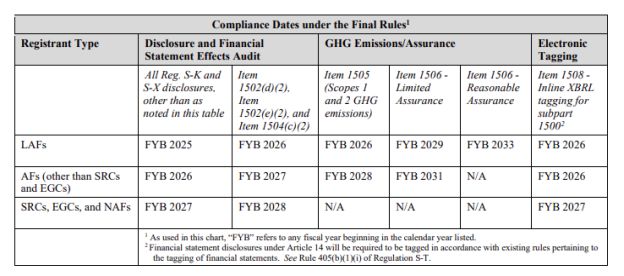On March 6, 2024, the U.S. Securities and Exchange Commission
(SEC) adopted the long-anticipated Climate-Related Disclosure Rules aimed at
enhancing transparency and disclosure around climate-related risks
and opportunities for U.S. public companies and most foreign
private issuers. The SEC received more than 24,000 comments
following publication of the proposed rules in March 2022.
While the final rules are meaningfully scaled back from the
proposed rules, notably eliminating the proposed requirement to
disclose Scope 3 greenhouse gas emissions, the final rules are
still some of the most sweeping and controversial ever passed by
the SEC. The SEC adopted delayed and staggered compliance dates for
the final rules that vary according to the filing status of the
registrant. Immediately upon adoption, the final rules were met
with lawsuits that challenge their validity and enforceability.
While states and businesses claim the new rules go too far,
environmental groups say the rules do not go far enough.
Notwithstanding the numerous legal challenges to the
Climate-Related Disclosure Rules that could delay or prevent
implementation that are described below, companies should consider
taking these recommended actions now:
1. Educate Management and the Board
- Consider a presentation to management and the company’s
board on the new rules. Do not assume that directors are aware of
these rules or their significance to the organization.
2. Assess Climate-Related Disclosure
Readiness
- Public companies that have not started to do so already should
assess what climate information they have and how it is collected,
tracked, measured, and monitored. - Does the company have the right third-party experts to assist
from an auditing and compliance standpoint? In addition to in-house
teams, these specialists can help ensure that companies have the
appropriate processes in place needed to identify, analyze and
disclose all information required by the Climate-Related Disclosure
Rules. The costs associated with complying with these rules is
anticipated to be significant. We expect that, since many companies
will be in the market for the same greenhouse gas (GHG) emissions
attestation service providers at the same time, costs may end up
being more expensive than for current attestation services. - Public companies should be aware that the Climate-Related
Disclosure Rules will affect their filings with the SEC
meaningfully. Companies should begin to assess where and how
climate-related disclosures will be presented in annual reports
(Form 10-K or 20-F) or in registration statements. Other than the
financial statement footnote, the narrative and quantitative
disclosures will be tailored for each company. For example, the
disclosure may be best accumulated in a new, standalone section
identified by the adopting release under the caption
“Climate-Related Disclosures”, or a company may prefer to
weave in disclosure across existing sections, such as Business,
Risk Factors, and MD&A. - The Climate-Related Disclosure Rules are expected to require
significant changes in internal control over financial reporting
and disclosure controls and procedures. These changes should be
considered now, as public company CEOs and CFOs will be required to
certify to the disclosures beginning with the report for the first
fiscal quarter of 2025. - From a governance standpoint, companies should take stock of
experience and oversight. Does management have the right mix of
experience to assess and manage risk? Which committee has
oversight, and are those duties accurately delegated in committee
charters? Does the company have an adequate policy for reporting
climate-related risks to management, the board or a board
committee? - With respect to a company’s overall ESG approach, companies
should review existing statements, goals and targets (whether in
SEC reports, CSR reports, on corporate websites, or otherwise), or
consider whether to adopt any such goals or targets.
3. Consider the Interplay of the Climate-Related
Disclosure Rules With Other Applicable Climate Disclosure
Rules
- Public companies should evaluate whether they are required to
report climate or related information under other laws, including
the three 2023 California climate disclosure laws (Senate Bills 253
and 261 and Assembly Bill 1305) and the EU’s Corporate
Sustainability Reporting Directive (CSRD).
4. Continue to Monitor Developments and Other Regulatory
and Government Efforts
- While companies do not have the luxury to adopt a wait-and-see
approach to see how the lawsuits are resolved, they should
nonetheless be mindful of the challenges from both sides. We will
keep you abreast of significant developments in this area.
Enhanced Disclosure Requirements
One of the central pillars of the Climate-Related Disclosure
Rules is the requirement for companies to provide comprehensive
disclosure regarding their climate-related risks and opportunities.
This includes detailing the effect of climate change on their
business operations, financial performance, and strategies for
mitigating associated risks. Some key disclosure items are:
- New Subpart 1500 – Climate-Related Disclosure in
Regulation S-K
- Greenhouse Gas Emissions:
- Scope 1 and 2 emissions will be required, “if such
emissions are material,” for registrants that qualify as a
large accelerated filer (LAF) or an accelerated filer (AF). Smaller
reporting companies and emerging growth companies are exempt from
this disclosure requirement. - Compared to the proposal, the final rules modified the proposed
assurance requirement covering Scope 1 and Scope 2 emissions for
AFs and LAFs by extending the reasonable assurance phase in period
for LAFs and requiring only limited assurance for AFs. - Meaningfully, the SEC eliminated the proposed requirement to
provide Scope 3 emissions disclosure, which the proposal would have
required in certain circumstances. Scope 3 emissions are indirect
greenhouse gas (GHG) emissions by the various components of a
company’s supply chain. The EPA describes Scope 3 emissions as
follows: “Scope 3 emissions are the result of activities from
assets not owned or controlled by the reporting organization, but
that the organization indirectly affects in its value chain. Scope
3 emissions include all sources not within an organization’s
scope 1 and 2 boundary. The scope 3 emissions for one organization
are the scope 1 and 2 emissions of another organization. Scope 3
emissions, also referred to as value chain emissions, often
represent the majority of an organization’s total greenhouse
gas (GHG) emissions.”
- Scope 1 and 2 emissions will be required, “if such
- Governance:
- The SEC eliminated the proposed requirement to describe board
members’ climate expertise. - New Item 1501(a) of Reg. S-K states, “If there is a
climate-related target or goal disclosed pursuant to [Item 1504 of
Reg. S-K] or transition plan disclosed pursuant to [Item 1502(e)(1)
of Reg. S-K], describe whether and how the board of directors
oversees progress against the target or goal or transition
plan.” - New Item 1501(b) of Reg. S-K states, “Describe
management’s role in assessing and managing the
registrant’s material climate-related risks.”…
- In providing such disclosure, provide …. “the relevant
expertise of such [management positions or committees responsible
for assessing and managing climate-related risks] in such detail as
necessary to fully describe the nature of the expertise”
- In providing such disclosure, provide …. “the relevant
- New Item 1504(a) of Reg. S-K states, “A registrant must
disclose any climate-related target or goal if such target or goal
has materially affected or is reasonably likely to materially
affect the registrant’s business, results of operations, or
financial condition.”
- The SEC eliminated the proposed requirement to describe board
- Greenhouse Gas Emissions:
- New Subpart 14 of Regulation S-X
- In a new footnote to the audited financial
statements:
- “[If meeting the disclosure threshold described below],
disclose the aggregate amount of expenditures
expensed as incurred and losses, excluding recoveries,
incurred during the fiscal year as a result of severe
weather events and other natural conditions, such as hurricanes,
tornadoes, flooding, drought, wildfires, extreme temperatures, and
sea level rise. For example, a registrant may be required
to disclose the amount of expense or loss, as applicable, to
restore operations, relocate assets or operations affected by the
event or other natural condition, retire affected assets, repair
affected assets, recognize impairment loss on affected assets, or
otherwise respond to the effect that severe weather events and
other natural conditions had on business operations.”
(emphasis added) - Disclosure will be required only when and if the aggregate
amount of expenditures expensed as incurred and losses equals or
exceeds one percent of the absolute value of income or loss
before income tax expense or benefit for the relevant
fiscal year (i.e., not required if less than $100,000). (emphasis
added) - Also, “[d]isclose whether the estimates and assumptions
the registrant used to produce the consolidated financial
statements were materially impacted by exposures to risks and
uncertainties associated with, or known impacts from, severe
weather events and other natural conditions, such as hurricanes,
tornadoes, flooding, drought, wildfires, extreme temperatures, and
sea level rise, or any climate-related targets or transition plans
disclosed by the registrant. If yes, provide a qualitative
description of how the development of such estimates and
assumptions were impacted by such events, conditions, targets, or
transition plans.”
- “[If meeting the disclosure threshold described below],
- In a new footnote to the audited financial
Materiality Assessment
The Climate-Related Disclosure Rules emphasize the importance of
materiality in climate-related disclosures and, in a departure from
the proposed rules, the final rules are generally less prescriptive
and include additional materiality qualifiers for certain climate
risk disclosures. With respect to GHG disclosures, even if the
registrant is confident its GHG emissions are not material, it
appears that the SEC expects them to be tracked in order to make
such a determination, and such tracking will need to be covered by
disclosure controls and procedures maintained in accordance with
the Sarbanes-Oxley Act of 2002.
Integration into Reporting Frameworks
The adopting release acknowledges that, where consistent with
the SEC’s objectives and the authority Congress granted,
certain provisions in the new rules are similar to existing
reporting frameworks, such as the Task Force on Climate-related
Financial Disclosures (TCFD) recommendations and the World Business
Council for Sustainable Development and World Resources Institute
Greenhouse Gas Protocol (GHG Protocol). The adopting release states
that “[t]he TCFD framework focuses on matters that are
material to an investment or voting decision and is grounded in
concepts that tie climate-related risk disclosure considerations to
matters that may affect the results of operations, financial
condition, or business strategy of a registrant.” Accordingly,
to streamline reporting and ensure consistency, the SEC encourages
companies to align their climate disclosures with these existing
frameworks.
The SEC also anticipates that because many companies already
adhere to TCFD standards, leveraging those “reporting
frameworks will mitigate those registrants’ compliance burdens
and help limit costs.” This alignment should facilitate
comparability and allow investors to better evaluate companies’
climate-related performance.
The adopting release also summarizes competing reporting
regimes, including ISSB standards (which some foreign jurisdictions
have adopted or plan to adopt); the European Union’s Corporate
Sustainability Reporting Directive; California’s
Climate-Related Financial Risk Act, which requires all U.S.
companies that do business in California with over $500 million in
annual revenues to make certain climate-related disclosures; and
California’s Climate Corporate Data Accountability Act, which
requires U.S. companies that do business in California with over $1
billion in annual revenues to disclose GHG emissions.
The SEC notes that the other laws and regulations may overlap
with its climate change rules, could reduce compliance and cost
burdens, and require separate disclosure outside of the SEC’s
public disclosure regime.
Compliance Timeline
This table on compliance dates was included in the adopting
release:

For example, an LAF with a Dec. 31 fiscal year end will not be
required to comply with the climate disclosure rules (other than
those pertaining to GHG emissions and those related to Reg. S-K
Item 1502(d)(2), Item 1502(e)(2), and Item 1504(c)(2), if
applicable) until its Form 10-K for fiscal year ended December 31,
2025, due in March 2026. If required to disclose its Scopes 1
and/or 2 emissions, such a filer will not be required to disclose
those emissions until its Form 10-K for fiscal year ended Dec. 31,
2026, due in March 2027, or in a registration statement that is
required to include financial information for fiscal year 2026.
Such emissions disclosures would not be subject to the requirement
to obtain limited assurance until its Form 10-K for fiscal year
ended Dec. 31, 2029, due in March 2030, or in a registration
statement that is required to include financial information for
fiscal year 2029.
The registrant would be required to obtain reasonable assurance
over such emissions disclosure beginning with its Form 10-K for
fiscal year ended Dec. 31, 2033, due in March 2034, or in a
registration statement that is required to include financial
information for fiscal year 2033. If required to make disclosures
pursuant to Reg. S-K Item 1502(d)(2), Item 1502(e)(2), or Item
1504(c)(2), such a filer will not be required to make such
disclosures until its Form 10-K for fiscal year ended Dec. 31,
2026, due in March 2027, or in a registration statement that is
required to include financial information for fiscal year 2026.
As an accommodation, the final rules provide that any GHG
emissions metrics required to be disclosed pursuant to Item 1505 in
an Annual Report on Form 10-K may be incorporated by reference from
the registrant’s Form 10-Q for the second fiscal quarter in the
fiscal year immediately following the year to which the GHG
emissions disclosure relates, or may be included in an amended
annual report on Form 10-K no later than the due date for such Form
10-Q. The extension of the deadline for the filing of GHG emissions
metrics also applies to the deadline for the filing of an
attestation report, which should accompany the GHG emissions
disclosure to which the report applies.
The SEC stated in its adopting release that this additional time
– an additional two fiscal quarters – should provide
registrants subject to Item 1505 and their GHG emissions
attestation providers with sufficient time to measure GHG
emissions, provide assurance, and prepare the required attestation
report. The final rules provide that a registrant that elects to
incorporate by reference its attestation report from its Form 10-Q
for the second fiscal quarter or to provide its attestation report
in an amended annual report must include an express statement in
its Annual Report on Form 10-K indicating its intention to either
incorporate by reference the attestation report from a quarterly
report on Form 10-Q or amend its annual report to provide the
attestation report by the due date specified in Item 1505.
Legal Challenges
Immediately after the SEC released the new rules, 10 states
(Alabama, Alaska, Georgia, Indiana, New Hampshire, Oklahoma, South
Carolina, Virginia, West Virginia and Wyoming) brought an action in
the U.S. Court of Appeals for the Eleventh Circuit arguing that the
SEC’s Climate Rules exceed the agency’s authority and are
arbitrary, capricious, an abuse of discretion, and not in
accordance with law. The states asked the court to declare the new
rules unlawful and vacate the SEC’s Climate Rules.
Since then, eight more cases have been filed in the Second,
Fifth, Sixth, Eighth, Eleventh and District of Columbia circuits by
Republican attorneys General, oil and gas industry groups, and
environmental advocacy organizations. While petitioners generally
chose to file in circuits that they perceived as sharing their
political perspective, following a request by the SEC on March 19,
the Judicial Panel on Multidistrict Litigation conducted a lottery
and the Eighth Circuit was selected to hear all of the consolidated
cases.
On March 15, on motion of petitioners Liberty Energy Inc. and
Nomad Proppant Services LLC, the Fifth Circuit granted an
administrative stay of the rules pending review. It is anticipated
that this stay will remain in effect at least until the cases are
consolidated in a single circuit. If a court other than the Fifth
Circuit is chosen, that court can determine whether to maintain or
dissolve the stay.
Based on public comments and statements since the final climate
rule was approved by the SEC, the bases for some substantive
challenges by attorneys general and business interests are likely
to include the Administrative Procedures Act (the APA) (i.e., the
rule is arbitrary and capricious, and contrary to law); the rule
exceeds the SEC’s statutory rulemaking authority: the Major
Questions Doctrine (climate disclosures are matters of “vast
economic and political significance” and there is no clear
Congressional authorization to regulate them); and the First
Amendment (i.e., the required disclosures are unconstitutional
speech).
Similar arguments doomed the SEC’s issuer share repurchase
rules, which were vacated at the end of 2023. Depending on the
decisions the Supreme Court makes later this term on pending cases
challenging the Chevron deference, these petitioners may also be in
a position to assert that no deference is due to the SEC decision,
and that the reviewing court has the power to weigh the evidence in
the record on its own.
At the other end of the spectrum, the Natural Resources Defense
Council and the Sierra Club, which filed petitions in the Second
Circuit and D.C. Circuit, respectively, are planning to argue that
the climate rule does not go far enough, Both are expected to argue
that the SEC’s decision to drop Scope 3 disclosures from the
final rule and soften Scope 1 and 2 disclosure requirements does
not satisfy the SEC’s obligations to protect investors and
provide them with the information they need to manage
climate-related financial risks.
The content of this article is intended to provide a general
guide to the subject matter. Specialist advice should be sought
about your specific circumstances.
#Key #Takeaways #SECs #ClimateRelated #Disclosure #Rules #Climate #Change










